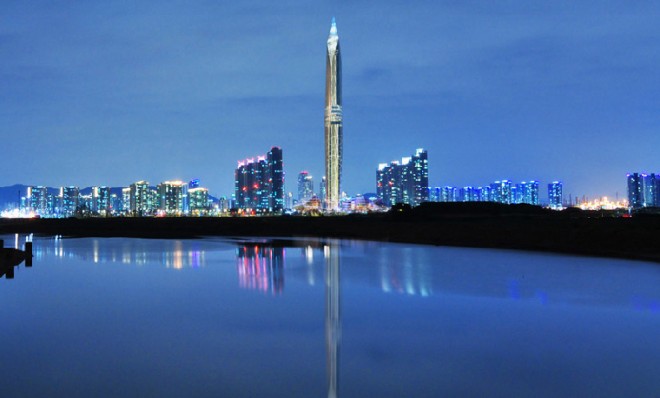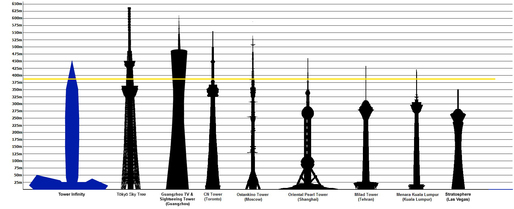Why South Korea is building an invisible skyscraper
The proposed Tower Infinity will use cameras and LED screens to disappear... really


We're in something of a golden age for skyscrapers. The boxy, stark modernism of Ludwig Mies van der Rohe has long since given way to curves and twists, and the race to create the tallest building is back in full swing, after the Sears Tower put the conversation to rest for 25 years in 1973.
A new skyscraper going up outside of Seoul isn't going to compete in the height race. At 1,476 feet, it's barely taller than the Sears (now Willis) Tower's 1,451 feet. The recently green-lighted Tower Infinity will have the third-highest observation deck, according to its designers at U.S. firm GDS Architects, but it's barely at shoulder height of the reigning champ, Dubai's Burj Khalifa (2,722 feet). It won't even be the tallest building in Seoul — the Light DMC building will reach 2,101 feet.
GDS lays out some of their proposed skyscraper's closest rivals:
The Week
Escape your echo chamber. Get the facts behind the news, plus analysis from multiple perspectives.

Sign up for The Week's Free Newsletters
From our morning news briefing to a weekly Good News Newsletter, get the best of The Week delivered directly to your inbox.
From our morning news briefing to a weekly Good News Newsletter, get the best of The Week delivered directly to your inbox.

But Tower Infinity will have something that no other skyscraper can boast: It will disappear into the skyline. Literally. Using a series of LED screens and 18 high-definition cameras, the "anti-skyscraper" will look invisible. At least that's the plan. Newsy runs through the basics:
What's the point of a tower that people won't be able to see? As the Newsy report suggests, tourism is a big reason. South Korea is trying to ramp up its tourism industry, and one-of-a-kind is a draw.
GDS gives a somewhat lofty rationale for its design, saying that "instead of symbolizing prominence as another of the world's tallest and best towers, it sets itself apart by celebrating the global community rather than focusing on itself." The "global community" bit is apparently a reference to cultural exhibits showcasing non-Koran cultures, including the slow-rising, large-capacity elevator. Alex Knapp explains at Forbes:
At different heights of the tower, the elevator will stop, and a screen will show a high resolution, real-time view of another world monument, such as a real-time view of New York City when the elevator reaches the height of the Statue of Liberty. [Forbes]
"Korea is a great country," GDS architect Charles Wee tells Forbes. "So if the world can see that we're mature enough to celebrate other cultures, that's a better monument to ourselves. It's more powerful." Wee explains that the design's big selling point was probably its novelty, though:
A free daily email with the biggest news stories of the day – and the best features from TheWeek.com
At this point we'd probably entered about 20 or 30 competitions, and I remembered looking at the competition briefs. All of them, it seemed, wanted whatever building it was to be a landmark. I thought to myself, 'How can we have that many landmarks?' So we took this idea, kind of as rebels, to take the concept and reverse it. We wanted to redefine what it meant to be a landmark.
From our perspective, Korea is an advanced nation. It doesn't need to show off. It doesn't need to fall into the meaningless race of building the tallest building. It could, but why? So, we thought, we'd do the opposite — make it disappear!... We thought we could use this to showcase Korean technology — it would be a magical thing to make such a large building disappear. [Charles Wee, to Forbes]
The plan worked. The committee selected GDS's design, and now the groundbreaking is slated for next year, with the completion date three to four years later.
GDS included this section of the Tao Te Ching in its proposal:
We look at it, and do not see it; it is invisible.We listen to it, and do not hear it; it is inaudible.We touch it, and do not feel it; it is intangible.These three elude our inquiries, and hence merge into one.Not by its rising, is it bright, nor by its sinking, is it dark.Infinite and eternal, it cannot be defined.It returns to nothingness.This is the form of the formless, being in non-being.It is nebulous and elusive. [Tao Te Ching, via Forbes]
If you haven't had enough of Tower Infinity, here's what amounts to the GDS press release, read aloud with photos:
Peter has worked as a news and culture writer and editor at The Week since the site's launch in 2008. He covers politics, world affairs, religion and cultural currents. His journalism career began as a copy editor at a financial newswire and has included editorial positions at The New York Times Magazine, Facts on File, and Oregon State University.
-
 Political cartoons for January 2
Political cartoons for January 2Cartoons Friday's political cartoons include college football chaos, an AI baby new year, and Putin's 'peace' plan for Ukraine
-
 Prickly pear juice recipe
Prickly pear juice recipeThe Week Recommends Jewel-toned, natural juice is a thirst-quenching treat
-
 The truth about vitamin supplements
The truth about vitamin supplementsThe Explainer UK industry worth £559 million but scientific evidence of health benefits is ‘complicated’
